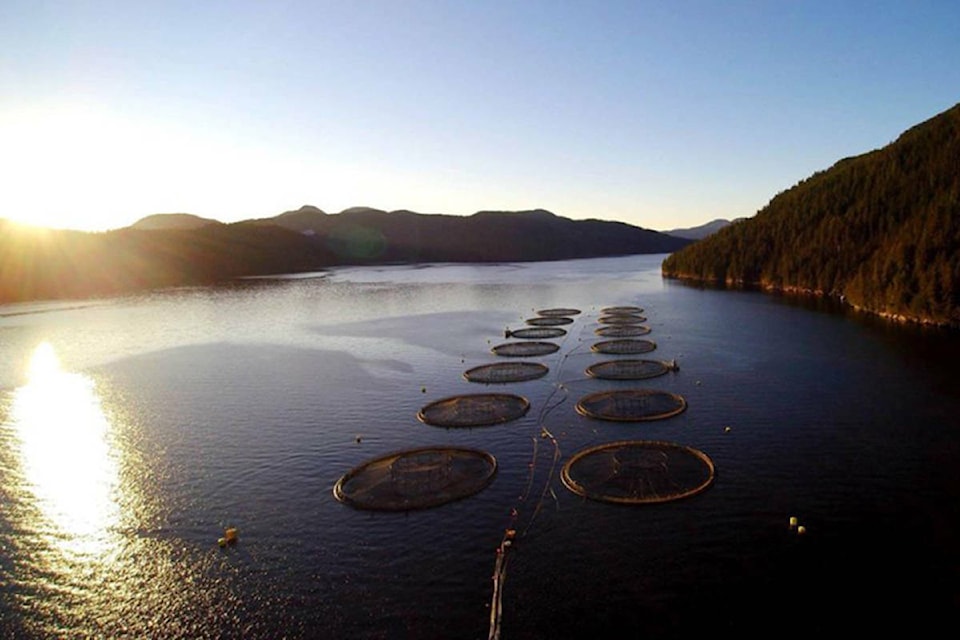Results of sea lice monitoring throughout the Discovery Islands show that levels of the parasite on wild salmon were unaffected by the 2020 salmon farm re-stocking ban, contrary to claims by ‘activists,’ an industry group says.
In a May 2021 Facebook post, independent biologist Alexandra Morton said the number of sea lice infecting juvenile wild salmon in the Okisollo Channel, located to the northeast of Quadra Island, declined by 95 per cent between 2020 and 2021. This was attributed to the December 2020 restocking ban for Discovery Islands salmon farms, which effectively halted aquaculture in the area.
But according to a report released on Nov. 25 by BC Salmon Farmers Association, a group representing 70 aquaculture industry organizations, results of third-party sea lice monitoring from across the Discovery Islands refute this alleged finding.
“What we found was, actually, that we couldn’t substantiate those claims in any way, shape, or form,” Brian Kingzett, science and policy director with BC Salmon Farmers Association.
“The accusation that has been made against industry was that the levels have gone from an average of nine lice per fish to zero,” added Kingzett. “What we see is average levels have been around less than 0.5 per fish, and remain there all the time, which would suggest they’re just a background level.”
Sea lice levels on wild salmon migrating out of areas with salmon farms have remained “consistently low” over five years of monitoring (2017 to 2021), he said.
“There’s variability, but they remain low in all cases,” he said. “Sea lice are natural in the ecosystem; they co-evolved with salmon, so we’re always going to see a background level of sea lice on any kind of salmonid in the ocean.”
This monitoring program, funded by three aquaculture companies, is conducted by Mainstream Biological Consulting Ltd., a Campbell River-based company.
At 29 sites, nets are deployed along the shoreline in the late spring, when young salmon are migrating. From the nets, 30 fish are randomly sampled, and later transferred to another organization, the BC Centre for Aquatic Health Sciences, in Campbell River, for analysis. First Nations fish guardians oversee and participate in this sampling.
This approach, targeting pink and chum salmon only, is scientifically robust and designed to minimize bias, said Lance Stewardson, Mainstream Biological co-founder and project manager.
“It would be very difficult to individually target and pick a fish out of a group of fish that are swimming within a net,” he said. “Our role is to collect consistent, valid data and present it.”
But as this program is industry-funded, it is not truly independent, said Stan Probsozcz, science and campaign advisor with advocacy group Watershed Watch Salmon Society. Unlike published scientific literature, BC Salmon Farmers’ report is not peer-reviewed, he added.
“It seems for industry and industry-aligned government agencies are the only ones who aren’t accepting that the sea lice debate is over,” said Probsozcz.
The report groups the monitoring data into three categories by the location of sample sites relative to area salmon farms and the south-to-north migration of wild salmon.
But monitoring data from the Okisollo Channel site alone, as published by Mowi Canada West, actually somewhat support Morton’s findings, said Andrew Bateman, research associate with Pacific Salmon Foundation, another advocacy group. At this site, the prevalence, abundance, and average intensity of sea lice infections declined from 2020 to 2021 for both pink and chum salmon.
“That’s basically what was reported earlier this year by those other independent researchers,” said Bateman. “Today’s report summarizes at a broader geographic scale, which serves to really gloss over some of the nuance and geographic realities that are contained in the data.”
However, one year of data is not enough to establish or refute a trend, said Batemen, adding it will take more detailed investigations with different data sources to fully assess the impacts of removing Discovery Island salmon farms.
READ ALSO: Researchers uncover and map biological hotspots of B.C.’s Central Coast
Fisheries audit: little improvement over past five years despite government commitments
sean.feagan@campbellrivermirror.com
Like us on Facebook and follow us on Twitter
